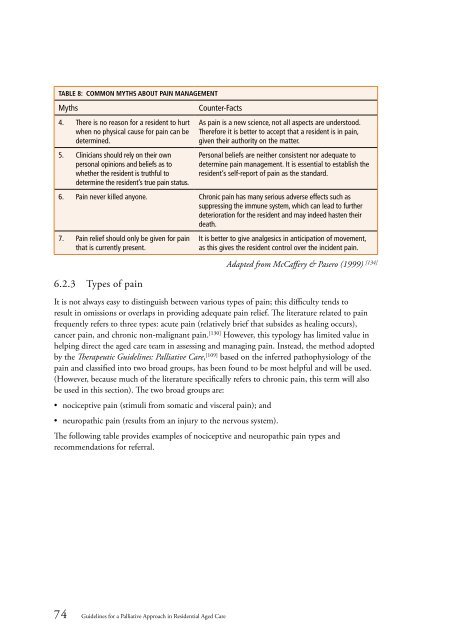Guidelines for a Palliative Approach in Residential Aged Care
Guidelines for a Palliative Approach in Residential Aged Care
Guidelines for a Palliative Approach in Residential Aged Care
You also want an ePaper? Increase the reach of your titles
YUMPU automatically turns print PDFs into web optimized ePapers that Google loves.
Table 8: Common myths about pa<strong>in</strong> management<br />
Myths<br />
4. There is no reason <strong>for</strong> a resident to hurt<br />
when no physical cause <strong>for</strong> pa<strong>in</strong> can be<br />
determ<strong>in</strong>ed.<br />
5. Cl<strong>in</strong>icians should rely on their own<br />
personal op<strong>in</strong>ions and beliefs as to<br />
whether the resident is truthful to<br />
determ<strong>in</strong>e the resident’s true pa<strong>in</strong> status.<br />
Counter-Facts<br />
As pa<strong>in</strong> is a new science, not all aspects are understood.<br />
There<strong>for</strong>e it is better to accept that a resident is <strong>in</strong> pa<strong>in</strong>,<br />
given their authority on the matter.<br />
Personal beliefs are neither consistent nor adequate to<br />
determ<strong>in</strong>e pa<strong>in</strong> management. It is essential to establish the<br />
resident’s self-report of pa<strong>in</strong> as the standard.<br />
6. Pa<strong>in</strong> never killed anyone. Chronic pa<strong>in</strong> has many serious adverse effects such as<br />
suppress<strong>in</strong>g the immune system, which can lead to further<br />
deterioration <strong>for</strong> the resident and may <strong>in</strong>deed hasten their<br />
death.<br />
7. Pa<strong>in</strong> relief should only be given <strong>for</strong> pa<strong>in</strong><br />
that is currently present.<br />
6.2.3 Types of pa<strong>in</strong><br />
It is better to give analgesics <strong>in</strong> anticipation of movement,<br />
as this gives the resident control over the <strong>in</strong>cident pa<strong>in</strong>.<br />
Adapted from McCaffery & Pasero (1999) [134]<br />
It is not always easy to dist<strong>in</strong>guish between various types of pa<strong>in</strong>; this difficulty tends to<br />
result <strong>in</strong> omissions or overlaps <strong>in</strong> provid<strong>in</strong>g adequate pa<strong>in</strong> relief. The literature related to pa<strong>in</strong><br />
frequently refers to three types: acute pa<strong>in</strong> (relatively brief that subsides as heal<strong>in</strong>g occurs),<br />
cancer pa<strong>in</strong>, and chronic non-malignant pa<strong>in</strong>. [130] However, this typology has limited value <strong>in</strong><br />
help<strong>in</strong>g direct the aged care team <strong>in</strong> assess<strong>in</strong>g and manag<strong>in</strong>g pa<strong>in</strong>. Instead, the method adopted<br />
by the Therapeutic <strong>Guidel<strong>in</strong>es</strong>: <strong>Palliative</strong> <strong>Care</strong>, [109] based on the <strong>in</strong>ferred pathophysiology of the<br />
pa<strong>in</strong> and classified <strong>in</strong>to two broad groups, has been found to be most helpful and will be used.<br />
(However, because much of the literature specifically refers to chronic pa<strong>in</strong>, this term will also<br />
be used <strong>in</strong> this section). The two broad groups are:<br />
• nociceptive pa<strong>in</strong> (stimuli from somatic and visceral pa<strong>in</strong>); and<br />
• neuropathic pa<strong>in</strong> (results from an <strong>in</strong>jury to the nervous system).<br />
The follow<strong>in</strong>g table provides examples of nociceptive and neuropathic pa<strong>in</strong> types and<br />
recommendations <strong>for</strong> referral.<br />
74 <strong>Guidel<strong>in</strong>es</strong> <strong>for</strong> a <strong>Palliative</strong> <strong>Approach</strong> <strong>in</strong> <strong>Residential</strong> <strong>Aged</strong> <strong>Care</strong>
















